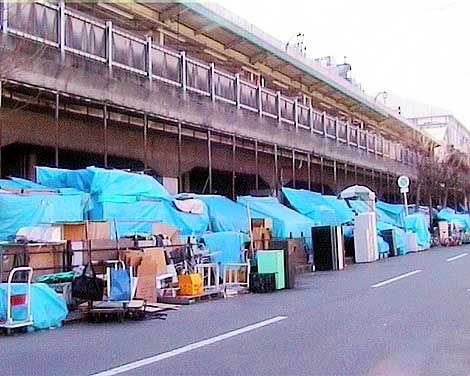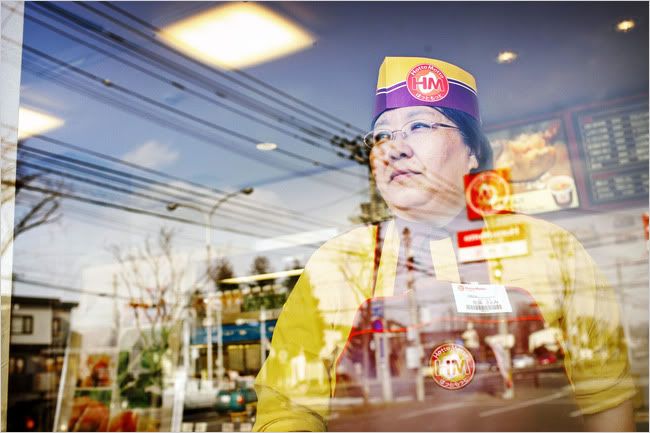An article published April 22nd, 2010 in The New York Times details Japan’s increasing problems with poverty and the country’s obstinacy in doing something about it.
Japan’s Post War Economy
The rapid growth of Japan’s post war economy throughout three decades earned it the nickname “Japanese Post-War Economic Miracle.” The 1960’s saw an annual growth rate of 10%. In the 70’s, it was 5%, and in the 80’s, 4%. The Supreme Commander of the Allied Powers (SCAP) played a large role in sparking Japan’s economic growth with investment, due SCAP’s belief that a strong economy would prevent a re-emergence of militarism and the rise of socialism. On the first point, it seems as though a lesson was learned from the Treaty of Versailles.
The Japanese also played a strong part in building their economy by placing nation and growth before self and profit. During the Japanese Post-War Economic Miracle, the cooperation of manufacturers, suppliers, distributors, and banks, formed into groups known as keiretsu, helped stabilized the nation. These groups allowed for horizontal and vertical integration that locked out all foreign competition.
The promise of lifetime employment at large companies and powerful unions in working class strongholds such as manufacturing plants also encouraged economic growth and active participation on the part of Japan’s citizenry. The participation of the government in investing in the economy and fortifying it through favorable legislation were each integral to Japan’s post-war economic growth.


The Shinjuku Skyline is a Testament to Japan's Economic growth; a tent city testifies to the Bubble's bursting
The Bubble Economy
The Bubble Economy and its bursting is an incredibly technical economic phenomenon, though to put in a nutshell: In 1985, the Japanese government deregulated interest rates on bank deposits. Because of this, banks had to compete for customers by offering the best interest rate. However, banks failed to raise their fees appropriately, and so were giving interest they weren’t actually earning as capital.
At first, banks sold stock to make up for the lost profit, though the stock well quickly ran dry. Banks began taking overseas loans, leveraged against which were property holdings. In 1990, the Tokyo Stock Market crashed, and along with it the banks, which found themselves with staggering loans to pay and no funds to pay them with.
The economic bleakness of the 90’s, in contrast to the bright lights of the 60’s – 80’s, have won the years the moniker The Lost Decade. Though the economy recovered well enough to maintain Japan’s status as second highest GNP in the world, the subsequent global recession of the 00’s has done the country no good.
While it’s easy to laugh about this (feel free to, though also take it seriously, please), Bloomberg.com published a report on escalating crime levels amongst senior citizens in Japan. Between 2006 and 2011, the Japanese government had made plans to cut $2.3 billion from its social welfare spending per year. In the middle of this, assistance to seniors began to run dry. Most senior crime is benign pick pocketing, though a 79-year-old woman slashed two women with a knife out of desperation.
After the economic crash, it wasn’t uncommon to see tent cities of Tokyo’s homeless sprinkled throughout the city. Complex communities lived beneath networks of blue tarps, a testament to the economic downturn.
Armchair Psychology
The New York Times humanizes its tale of poverty and politics by focusing on a middle-aged woman, Satomi Sato, raising a teenage daughter in the town of Memuro. Sato makes the equivalent of $17,000 a year, split between two jobs. In the morning she makes bentos (boxed Japanese lunch), while in the afternoon she delivers newspapers.
“I don’t want to use the word poverty, but I’m definitely poor,” Sato mused in an interview with the Times reporter. “Poverty is still a very unfamiliar word in Japan.”
Poverty being new in Japan is of course a fabrication. There were working and servile classes throughout Japan’s Imperial epoch, and rampant starvation, destitution, and violence during the time of the Shogunate. In the 50’s, Japan was suffering through the post-war malaise on a largely black-market economy. That Japan, however, is a Japan of the past.
What Satomi Sato is saying when she says that poverty is unfamiliar in Japan is that poverty in the modern sense, with its plethora of undesirable and highly visible baggage, is unfamiliar in modern Japan. Though Japan has always had it’s working classes, the idea that there are millions of citizens in the country who struggle and even need assistance to get by, is a massive blow to the Japanese ego.
Reads The New York Times Report: “Many Japanese…were further shocked to see that Japan’s poverty rate, at 15.7 percent, was close to the…figure of 17.1 percent in the United States, whose glaring social inequalities have long been viewed with scorn and pity here.” And while scorn is a large part of it, the Japanese also have their pride.
Having recovered from World War Two in startling fashion, Japan has been a nation with no need of foreign assistance for the better part of a century. To see that the country now has similar financial inequities as a nation that not only nuked Japan, but also embarrassingly occupied it in the post-war years and is rife with problem such as inner-city violence, racial strife, and homelessness, is a great blow to the Japanese pride and belief that the Japanese system – economy, social programs, education, health care, et al – is second to none.
Some poor Japanese citizens even try to obfuscate their poverty on account of this pride. An annual lifestyle survey in August of 2009 showed that 80% of Japanese citizens think of themselves as middle class. “Saying we’re poor would draw attention, so I’d rather hide it,” Sato said in her interview.


Satomi Sato works her morning job while the desperate elderly prepare to rob her.
Where To Now?
In the summer of 2009, Japan elected a left wing government in favor of previous office-holders and moderates, the Liberal Democratic Party. Headed by Prime Minister Yukio Hatoyama, the government is finally owning up to what has long been a problem swept under the rug.
The new government has set a poverty line at $22,000, and gone public with years of secretly kept statistics on poverty. However, according to an expert quoted in the Times article, “We are at risk of creating a chronic underclass.”
Of course there’s a bit of Doomsday Prophesizing to all of this. The same survey (“Growing Unequal? Income Distribution and Poverty in OECD Countries" – 2008) that listed Japan’s poverty rate at 15.7% asserts that, though wages nation-wide have declined since 1998, and poverty increased, the nadir of the problem has passed. Income inequality and poverty were at their height in Japan in the mid 00’s.
Japan has proven itself time and again an incredibly resourceful and intelligent nation. If the country focuses on this problem, they can no doubt make it go away. Japan has also proven itself, however, to be an incredibly prideful nation equally capable of ignoring the elephant in the room until the whole building crumbles.
We also must dutifully consider the fact that, despite the foreign fetishization of Japanese esotericism, there are very cosmetic tendencies in Japanese society. The Japanese mainstream may very well be willing to ignore this problem as long as it remains relatively unseen. But then, if it doesn’t, vanity may prove to be a great motivator. Which way the wind will blow in this pressing matter is yet to be known; here’s to hoping Japan rescues herself again.


4 comments:
I think American English should get back together and do a benefit tour for the poor nihon jin. First stop, the Ruby Room...
Here here. Motion seconded.
Desert Safari Dubai provides a variety of all comprehensive packages for distinct types of desert safari, Our desert safari involve many varying options like dune buggies and quad bikes.
desert safari dubai
Desert Safari Dubai provides a variety of all comprehensive packages for distinct types of desert safari, Our desert safari involve many varying options like dune buggies and quad bikes.
desert safari dubai
Post a Comment